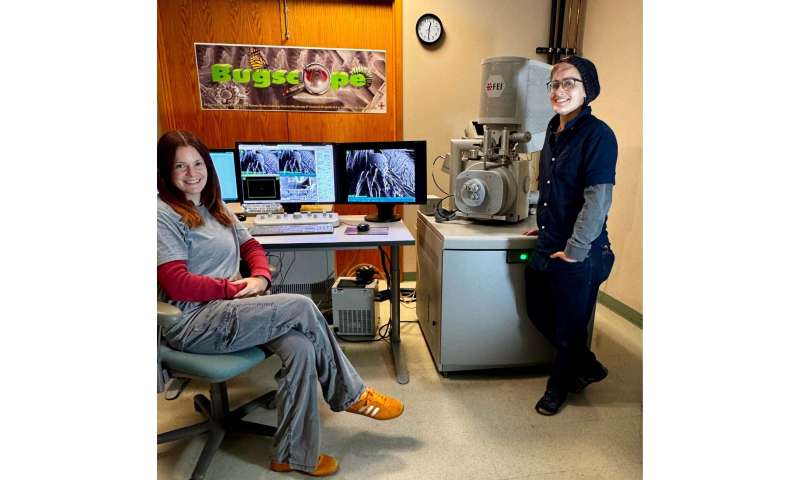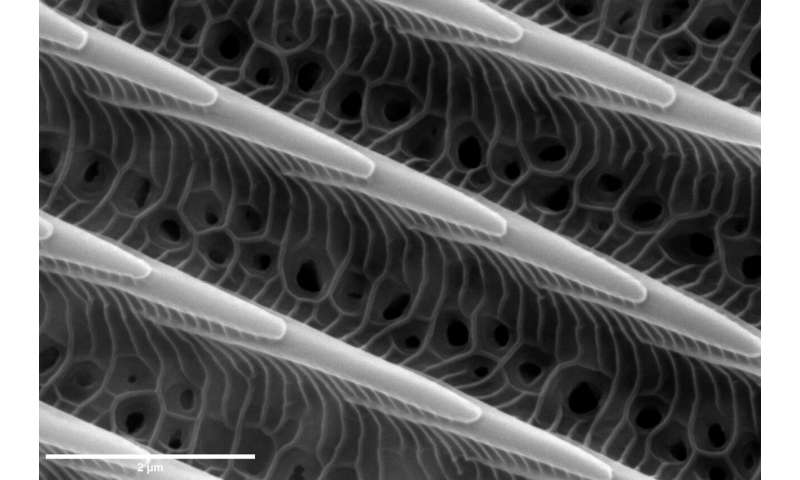Bugscope: 25 years of thrills and chills

Bugscope is gearing up to celebrate 25 years of science outreach and education. Since its inception in 1998, the free, web-based outreach program has connected thousands of students with microscopists at the Beckman Institute for Advanced Science and Technology to collect, explore, and image insects under a high-powered scanning electron microscope.
Beckman Institute Microscopy Suite Manager Cate Wallace and microscopist T. Josek, both University of Illinois Urbana-Champaign alumni, lead the Bugscope program, which is hosted via live Zoom sessions. Their team motto is that anyone can get involved; their primary goal is to get kids excited about insects and scanning electron microscopy.
The scanning electron microscope used for this program is different from traditional light microscopes because it uses electrons instead of light to probe materials, enabling greater magnification and depth of view. The microscope is physically located in the basement of the Beckman Institute, but Bugscope's virtual platform means that almost anyone in the world can access it.
"So far, Bugscope has hosted more than 1,000 sessions that have reached more than 9,000 students from 48 U.S. states and several other countries including Africa, Australia, Brazil, Canada, China, Great Britain, and Ireland," Wallace said. Reaching the last two U.S. states—Delaware and North Dakota—is on Wallace's wish list.
Here's how it works: K-12 classrooms can apply for a Bugscope session with the online application form. Once approved, the Bugscope team will send a confirmation email to set up a date and time for the live session. In the meantime, students are encouraged to send insects from their backyards, windowsills, or even class field trips to Wallace and Josek, who prepare them for imaging.
With Bugscope, students can see things that they cannot see—or do not expect to see—with their own eyes, like parasitic insects atop other bugs or bacteria and microscopic plankton like diatoms, said Wallace.
The program also highlights the importance of exploratory work—a student's observation may spark a new interest or even be a new discovery.
Accidental discoveries happen all the time, said Josek, who is an entomologist by training and especially enjoys hearing kids exclaim in surprise or shock when they see something cool or learn something new.
Bugscope is a valuable educational resource for students and teachers alike. Sessions support teachers by facilitating lesson plans that fit educational standards; they support students by making science more accessible and encouraging curiosity, discovery, and independent thinking.

When teachers return for multiple sessions, it means that "they enjoy it and it's working; everyone is excited. That is telling me that teachers value the program and that we can help to take a load off of their plates," said Josek, who also has a background in teaching.
In one circumstance, Josek worked with Allison Gardner, a medical entomologist and associate professor of arthropod vector biology at the University of Maine, to devise a research-based lesson plan. Students were required to generate research questions, determine which insects to collect, and use the imaging results to answer their research questions. Josek is planning to repeat this lesson in fall 2023 and to conduct a similar lesson with a biology class from the local Academy High during spring 2024.
In addition to connecting with classrooms, Bugscope has participated in other outreach events like the annual Insect Fear Film Festival hosted by the University of Illinois' entomology department, Bugapalooza hosted by the Peggy Notebaert Nature Museum in Chicago, and the Beckman Institute Open House. Bugscope also received the Science Prize for Online Resources in Education Award from the journal Science in 2011.
The program was conceived in 1998, when Clint Potter and Bridget Carragher wrote a successful National Science Foundation grant to purchase a $600,000 scanning electron microscope. Shortly after the approval, now-retired Microscopy Suite Manager Scott Robinson was hired to install and operate the new microscope and to head the Bugscope program. He led the first official session on March 19, 1999, and continued to direct the program until his retirement in 2021.
"We absolutely love when students ask a lot of questions. Sessions can get pretty crazy, with students asking a million different questions, but we encourage it. We want them to be engaged by what they're seeing," Robinson said in a 2014 article that celebrated Bugscope's 15th year.
The Bugscope team has a few goals in mind. Josek plans on continuing to develop Bugscope lesson plans and wants to increase the number of weekly Bugscope sessions. Wallace would like to restore the ability for students to remotely operate the microscope and is looking for additional volunteers to help run the sessions, particularly those with a background in entomology or other insect-related sciences like agriculture and crop science.
Provided by Beckman Institute for Advanced Science and Technology